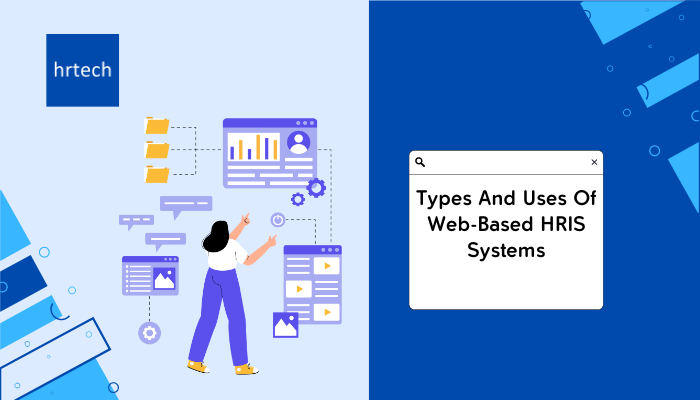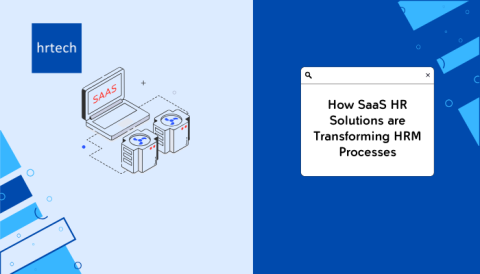In this guide, you’ll learn from scratch what an HRIS system is, its types, benefits, uses, and more, along with examples.
We’ll share everything you need to know about HRIS systems so that you can easily choose the right tech solution for your company. Ready? Let’s get started.
Transforming HR through Agile Workforce Solutions
What Are Web-Based HRIS Systems?

A web-based HRIS is a type of HR software you can access online. You don’t need to install it on your computer. This makes it easy for you and your team to use the system from anywhere.
Web-based HRIS systems help you manage important HR tasks online, such as:
Keeping track of employee information
Managing payroll and benefits
Posting job openings and hiring new people
Tracking time off and attendance
Measuring employee performance
Making HR reports and analyzing data
With a web-based HRIS, your HR team can work smarter and better support your employees. It’s a great tool for companies of all sizes who want to optimize their HR processes.
Now that you know what web-based HRIS systems are, let’s examine the key benefits they offer to HR teams and organizations.
Benefits Of Web-Based HRIS Systems
Did you know that the majority of HR’s time – close to 73% is consumed by the same repetitive tasks? That’s why it’s crucial to use effective HRIS systems to automate them and improve the workflow.
Web-based HRIS systems offer many benefits to HR teams and companies. Here are some of the top advantages:
Automates repetitive tasks like data entry and reporting.
Reduces paperwork by going digital.
Keeps all employee data in one secure place.
Avoids errors from manual data entry.
Gives real-time updates across the system.
Sends alerts for compliance deadlines.
Generates required reports easily.
Lets employees update their own information and request time off.
Improves employee satisfaction and retention.
Next, let’s explore the various uses of web-based HRIS systems and how they can support different HR functions.
Uses Of Web-Based HRIS Systems
Web-based HRIS systems are very useful for managing all aspects of HR. They can help with many different tasks, such as:
1. Recruitment and Hiring:
Posts job openings online.
Tracks applicants and resumes.
Schedules interviews and sends offers.
2. Employee Data Management
Keeps track of employee information like job history, performance, etc.
Updates records easily when things change.
Stores documents securely in the cloud.
3. Benefits Administration:
Manages employee benefits like health insurance and retirement plans.
Lets employees enroll and make changes online.
Generates reports for compliance.
4. Time and Attendance Tracking:
Records employee work hours and time off.
Approves timesheets and requests.
Integrates with payroll for accurate pay.
Types Of Web-Based HRIS Systems With Examples

There are many different types of web-based HRIS systems out there. Each one has its own set of features and benefits. Here’s a breakdown of the main categories:
1. Core HR Systems
These systems focus on basic HR functions like:
Storing employee data
Managing documents
Ensuring compliance
Examples include: BambooHR, Zenefits, Gusto, Namely, Rippling, GoCo,and more
2. Strategic HR Systems
These systems help with higher-level HR tasks such as:
Attracting and hiring top talent
Onboarding new employees
Evaluating job performance
Identifying future leaders
Managing learning and development
Popular examples include: Workday, SAP SuccessFactors, Oracle HCM, ADP, Cornerstone OnDemand, and more.
3. Workforce Management Systems
These systems help manage and optimize your workforce by:
Creating employee schedules
Tracking work hours and time off
Managing shift swaps and coverage
Monitoring attendance and absences
Analyzing costs and productivity
Well-known examples include: Rippling, Zenefits, Connecteam, UKG, Paycom, Paylocity, and more.
Want to explore different HR tech solutions? Check out or hrtech’s marketplace to check out a wide range of HRIS software systems. From dedicated to all-in-one options, you’ll find all options. Explore now!
Advantages And Challenges Of Web-Based HRIS

While web-based HRIS systems offer many benefits, it’s important to understand both the advantages and potential challenges. Here’s what you need to know:
Immediate And Easy Accessibility From Anywhere:
One of the biggest advantages of web-based HRIS is that you can access the system from any device with an internet connection.
This makes it easy for HR staff and employees to use the HRIS system remotely, which is especially helpful for companies with multiple locations or remote workers.
Regular Backups And Updates Ensuring Data Protection And Compliance
Web-based HRIS systems are regularly backed up and updated by the provider.
This helps ensure that your HR data is protected and that the system stays compliant with changing laws and regulations. You don’t have to worry about maintaining the system yourself.
Global Compatibility For International Workforce Management
If your company has employees in different countries, a web-based HRIS can be a great solution.
Many systems offer multi-language support and can handle different currencies, tax laws, and compliance requirements. This makes it easier to manage a global workforce.
Potential For Increased Risk Due To Data Leaks
However, because web-based HRIS systems store sensitive employee data online, there is a potential for increased risk of data leaks. It’s important to choose a reputable provider that has strong security measures in place to protect your data.
Dependence On Internet Connectivity
Another potential challenge is that web-based HRIS systems require a reliable internet connection to function properly. If your internet goes down, you may not be able to access the system, which could disrupt HR processes.
Integration Challenges With Other Business Systems
Finally, integrating a web-based HRIS with other business systems, such as payroll or accounting software, can sometimes be challenging.
It’s important to choose an HRIS that offers good integration capabilities or has pre-built integrations with the systems you use. Now, let’s see what are the key features to look for in a web-based HRIS system.
Key Features Of Web-Based HRIS Applications
When choosing a web-based HRIS, it’s important to look for a system that has all the features you need to manage your HR processes effectively. Here are some of the key features to consider:
Recruitment and Onboarding
A good HRIS should help you optimize your hiring process from start to finish. Look for features like:
Job posting and applicant tracking system (ATS)
Resume parsing and screening
Interview scheduling and feedback
Onboarding checklists and workflo
For example, softwares like Greenhouse, Workable, and JazzHR can post your jobs to multiple boards and track candidates through each stage. Furthermore, softwares like BambooHR can automate your onboarding process with tasks and necessary forms.
Payroll Management
Payroll is an essential HR function that can be complex and time-consuming. An HRIS with solid payroll features can automate many tasks, such as:
Calculating wages, taxes, and deductions
Processing direct deposits and paychecks
Integrating with time and attendance systems
For instance, software like ADP and Paychex can handle complex pay calculations and ensure compliance.
Benefits Administration
Managing employee benefits is another key HR responsibility that can be simplified with an HRIS. Look for a system that can handle:
Open enrollment and life event changes
Carrier connections and data exchanges
Premium calculations and deductions
Automating benefits tasks, you can provide a better experience for your employees while ensuring compliance with regulations.
And to give you an idea of how it works, think of softwares like Benefitfocus. They can easily calculate premiums and deduct them from the payroll accordingly.
Employee Self-Service Portals
Giving employees access to their own HR information can save time for everyone involved. A good HRIS should offer self-service features like:
Online access to pay stubs and tax forms
Ability to update personal information
Time off requests and approvals
Benefits enrollment and changes
For instance, softwares like BambooHR and Zenefits have built-in PTO tracking and approval workflows.
Performance Management
Finally, an HRIS can help you track and optimize employee performance over time. Key features to look for include:
Goal setting and tracking
Performance reviews and feedback
Succession planning and career development
For example, platforms like BetterWorks and Lattice make it easy to set goals. Software like PerformYard streamlines the performance review process with automated reminders and online forms.
So now that you know the key features, how do you decide which software is best for your needs? Let’s find out!
How To Select The Right Web-Based HRIS For Your Company
Choosing the right web-based HRIS is a big decision.
You want a system that will meet your company’s needs now and in the future. Here are some key factors to consider:
Start by looking at your current HR processes and challenges.
What tasks take up the most time?
What do you want to improve?
Make a list of must-have features and nice-to-haves.
Also, think about your existing IT setup. Will the HRIS work well with the other systems you use? Involve your IT team in the process. Now, if your company is growing or has global operations, you’ll want an HRIS that can scale with you.
Look for a system that can handle multiple languages, currencies, and compliance requirements. Ask about the provider’s experience with companies of your size and in your industry. Can they handle your specific needs?
It’s important to protect employee company data. That’s security should be a top priority. Ask potential providers about their security measures, including encryption, backup procedures, and employee access controls.
Also, ensure the HRIS can help you comply with relevant laws and regulations, such as GDPR and HIPAA.
Conclusion
So, a web-based HRIS system is a cloud software that optimizes HR processes and saves time.
When choosing an HRIS, consider your company’s unique needs. Look for a system with the right features and scalability. Don’t forget about security and compliance too.
The goal is to find an HRIS that works with your budget and can grow with your company.
Setting up a new HRIS system can seem a bit challenging at first. But it’s totally worth it because your HR team will work better and have more time to focus on important things instead of getting stuck with everyday tasks.
If you need help finding the best HR technology, check out hrtech – our team of HR experts can guide you in selecting the right software solution for your company.





